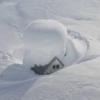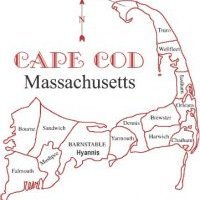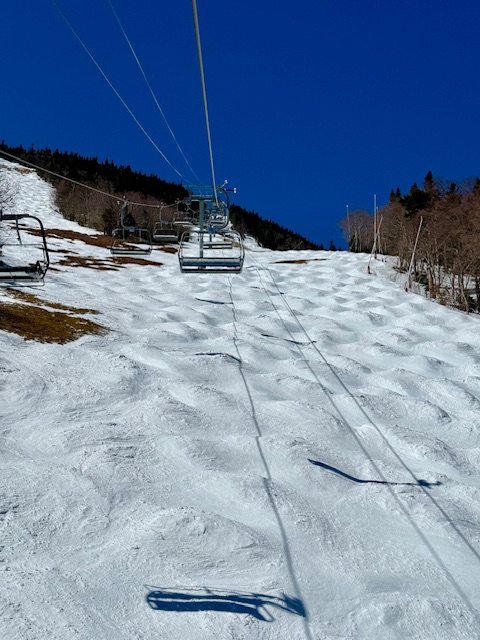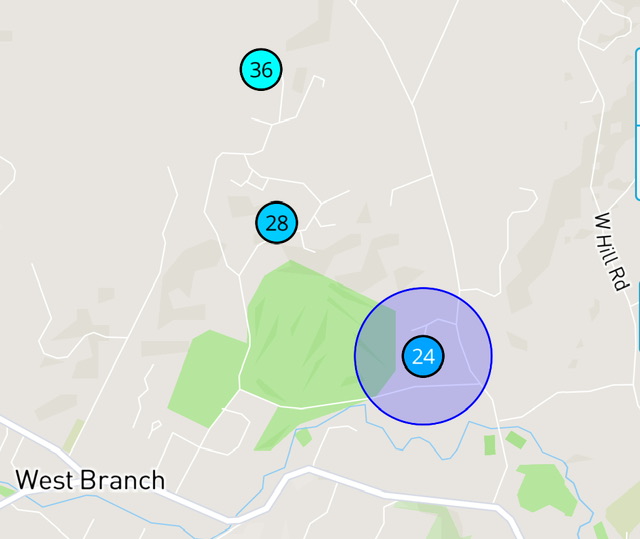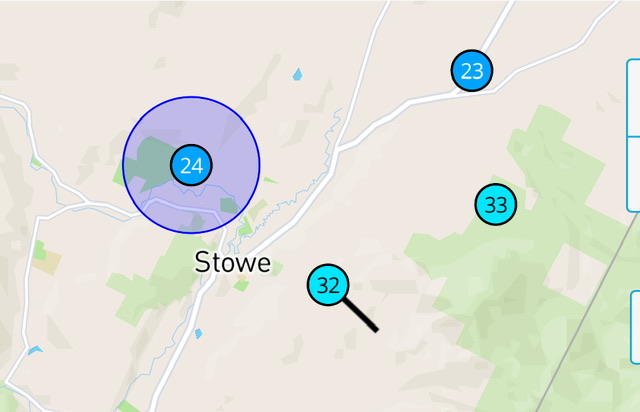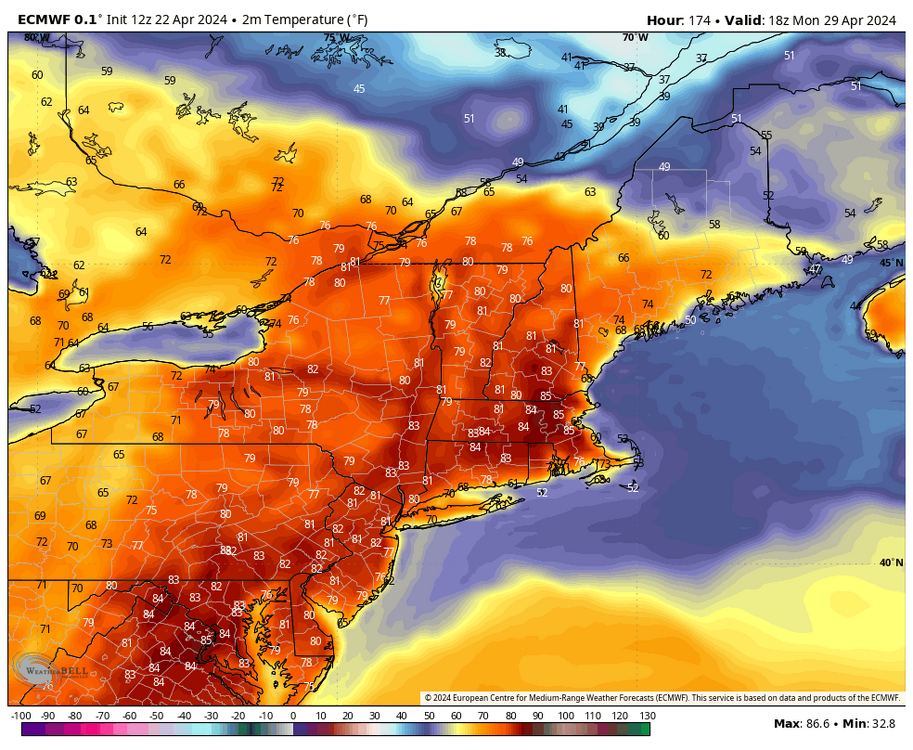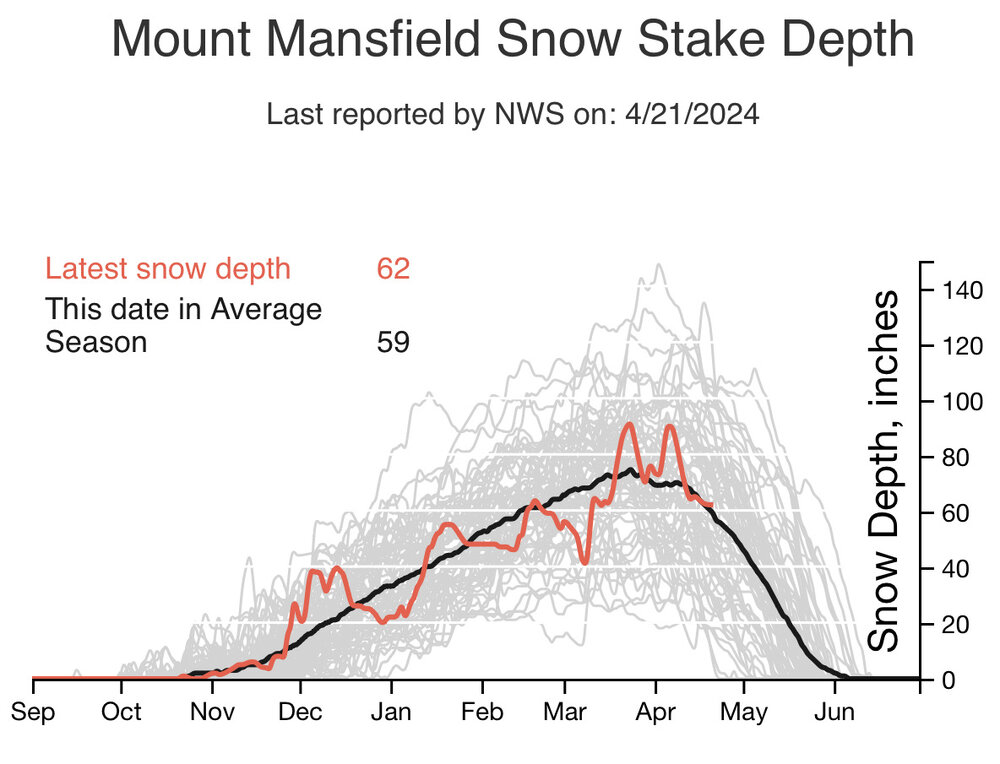-
Posts
70,667 -
Joined
-
Last visited
-
Hey, I’ll agree. What makes Killington special is that the others close down. That’s what drives the economic demand. If all the ski areas stayed open, it would dilute the market and diminish the vibe at Killington this time of year. Part of that excitement and feeling is because of the diminished supply, which focuses the stoke into one area. Economic principles rule all. Stowe could operate for sure, but I’ve seen too many empty chairs to believe it is worth it. When everyone is open this time of year, the market is diluted. We all enjoy skinning and earning our turns too, at least the folks that like this transition season. Most of the community is onto Mtn Biking (MTB), maybe a skin up here or there, but closing at this juncture just doesn’t illicit any outrage. It’s time here, despite the snowpack.
-
66F from 23F at the nearest PWS here on the other side of the river. MVL ASOS was 68F from 24F, for a 44 degree diurnal swing out in the air field. Top 10 day.
-
One other thing is that skiers and riders know their ski area over time and know what the number means. This discussion came up on the lift this winter with someone who skis at one spot midweek and another on the weekends. They told me we must be using a different ruler than a nearby hill because the same number on one report led to different skiing than that same number on another report. But I countered that it’s just a different method and that she could already identify what each number means just by the conversation. In her head, she already knew what the snowfall on each report meant, correlated to and how it would ski. We discussed instead of comparing the numbers, just recognize what it means. And that’s really what a Snow Report is for. Be consistent however you want to do it, so people know what it “means.”
-
Yeah I hope that came across as just apples to oranges, not good vs bad. It’s just important to recognize when comparing both snowstorms and seasonal snowfall. Is it a consistent spot in sort of the new version of snow reporting over the past decade or so… or is it the old school estimated range style. Both can be or feel correct for any given storm but over time adding up the deepest snow on property will lead to a different total than the same patch of woods over a season. That old school style is a part of northeastern ski culture too. Out west has always been a one number one plot game for avalanche purposes, where East was always a “you can find between 8-12 inches out there” type of vibe. I always found it more stressful to have to come up with estimates, I enjoy just showing people the readings and saying it is what it is, ha.
-
I did ask a former marketer at Jay and he didn’t know of any spots, confirmed the sort of old school crowd sourced range method between grooming, patrol, skiing around. I did that when I started here but it’s stressful, ha. Easier to have something tell you what it is instead of hemming and hawing “how much do you think this seems like?” TK thinks we are low even when I show him the actual measurement lol. Was hanging with him last weekend, love skiing with that dude, the enthusiasm is hard to beat. Which also plays into snowfall… skiers love snow, get excited, want to be stoked and I won’t lie, I bet 90% of skiers on a powder day would over-estimate snowfall. “Dude, that was so deep, had to be a foot and a half.” Plot shows 13”. Ha. Just like we’ve seen with weather weenies, sometimes excitement gets the best of everyone and I’ll admit, without seeing it on a stake I would estimate higher too. It’s human nature. A plot keeps me in check. The number of text convos we sometimes have that are like, “man it seems like so much more snow.” “No dude, we report what’s on High Rd. It is what it is.” The three of us gut check each other occasionally that way throughout the season. Thats how estimates might be 12-18” in the old school style, but turns to 13” these days. And you see the seasonal total drop over time. And skiers think both are correct, because they are for the most part. It’s just different ways of doing it.
-
TLDR - It's sort of comparing apples to oranges depending on the snow reporting method. Old school ranges or single site snow cam or plots. Ski Areas around the region are sort of a mixture of both methods.
-
I know this is a sensitive subject and what I'm about to say is not accusing anyone of misleading or trying to be higher or market snowfall more. Smuggs has moved to a more controlled snow measurement with a branded measuring spot I've seen posted a few times. I think that's what you are seeing there. To me, Bolton stands out much more than Smuggs on that list. Did Bolton get almost 100 more inches than MRG this winter? Really think about that for a second. That's 8 more feet of snow, the snow depths must've really reflected that too? I have personally seen it happen at Stowe and truly believe it to be the case, that if you are doing the old school estimating snowfall version of Snow Reporting (just skiing around, finding a general 8 - 10 inches depending on where you are, and then always adding the higher value to the season total) you will have a noticeably larger season total over time. It isn't wrong per se, and skiers/riders won't find it off because they are skiing sometimes in 7-8 inches and sometimes they find some turns with 10 inches of new snow. But you are taking the deepest amount found in any storm and adding it up over time... and those deepest places aren't always in the same spot though depending on wind direction. Look at the ski areas that have gone to a more controlled measuring... Sugarbush has their stakes and cams, so does MRG. Smuggs looks to have pivoted to that direction from what I noticed the past couple seasons. We've gone that way at Stowe too. The two locations I have yet to see a consistent measuring site or some sort visual proof of like a plot or spot are Bolton and Jay. Again, this doesn't mean they are fibbing or making things up, but just going about it the old school way. But you'll see their numbers stay in-line with the old school numbers, which are a bit higher. An example is for those who have ever worked in Operations, say you call Ski Patrol to ask how much snow has fallen? You are going to get a range as an answer every single time. Just like if you asked any skier or rider. How much snow was there? Oh there was 6 - 8 inches out there on the hill. Sounds good. And it's usually correct that the snowfall will be in that range as one skis around a mountain. However, what if you only measured from one specific location or two specific locations? All the sudden the place you chose to represent snowfall shows 6.5". Now you are deciding to report 6, maybe 7 if you want to push it, but not 8 that the old school method would be. Take Bolton... when J.Spin goes up there he usually finds the reported snowfall in his wanderings around. But I'd be curious what that snowfall might look like if he went to the same exact location every single time. Maybe he finds only 7" at the designated spot because the storm came with a strong east wind, but skis around in the woods on his tour at some other aspect and finds 9" or 10". Old style would say there was 7-10" of new snow (maybe even 6 - 10 inches), but now the 7 would get recorded in the annual tally not 10. There is a subtle difference that adds up over time when talking about dozens and dozens of snowfall reports over a season. The larger the snowfall range I see from a ski area, the more likely I know they are going old school and estimating. Unless it is a highly marginal elevational storm with slop and pow up high, 6-10" on a snow report is a forecast, not a snowfall measurement. If I see "24 Hour New Snow: 8 - 14 " that's just tossing numbers out there in a windy snowstorm. Synoptic events and even upslope won't give anywhere near that range even at elevation. Synoptic events I've noticed are often very close between elevations and summits. The lift is occurring in the mid-levels. There's no reason for a large range of more than an inch or two. But occasionally we see these big ranges on snow reports, but that's the old school snow reporting method. No one will convince me otherwise, but there is a total snowfall difference annually between the old school estimated range method and any mountain that goes to a singular specific location that shows just one number and one number only with no adjustments. I believe we are seeing it happen with Smuggs now too, corrects downward. Old school snow report ranges of snowfall does capture a mountain's snowfall well in each specific event in my opinion, but will lead to compounding overtime as it is always taking the deeper value and adding it onto itself. As opposed to taking one number from the same exact location or two locations all season, regardless of wind direction, nuances, etc and adding that up.
-
It’s really nice out. 24F to 57F already before 11am.
-
Those days where it’s -20F in the mountain valleys up here in the morning and raining at 34F by dinner, lol. Those are the memorable ones.
-
lol, radiators mount up I guess. 24F at the neighbor’s station here near the river and country club, but 36F up the hill. Valley bottom a good 10F colder than even a couple hundred feet up.
-
Looking back on yesterday's closing day, this was my social post about the awesome day the local crew had. This large assembled crew is the heartbeat of the Mansfield ski/ride community... "Through all the powder days, rain storms, hurricane force wind gusts, sunny days, soft snow days, frozen granular days and everything else, today might have been one of the most memorable of the season (well, aside from that cosmic event). The end of the season is always bittersweet. On one hand, for myself and mountain colleagues, it’s liberating to take a break after 156 days of operations. On the other hand I always know I’ll miss the Stowe Family, the stoke and the Mansfield ski & ride culture over the summer. Despite greybird skies and chilly weather, the Stowe Family showed up in force today to celebrate another season of sliding on snow. That culminated with the grassroots 4th Annual Human Slalom. This was incredible and is getting penciled into Stowe closing day lore and tradition already. There are too many people to tag in these photos but hats off to Matt Testa aka Matty Mansfield for leading this grassroots charge and organizing the massive human slalom down Nosedive, after everyone grabbed some gnar points with some pole whacks on the Nosedive turns. Between the organic gatherings like the largest human slalom, the Quad top dance party, and the last chair gathering on the Octagon deck to celebrate the season, the vibes were high out there. Today proved the ski & ride culture is strong on Mount Mansfield and every single one of us plays a role in that. I feel lucky to be a part of it and to document it throughout the winter season. Thanks to all who contribute to the vibe, this community is awesome. My heart and soul are full today."
-
-
The 1pm ob at MVL was 40/9. Up to 45F now but I’m going to say in the sun it does feel warmer than that. Hoodie while active is plenty warm enough right now. This in November would feel frigid. Weird how the body changes throughout the year.
-
Further supporting the case for average snowfall is the snow depths on hill at elevation were about as normal as it gets in the means. One thing that stands out that skiers noticed this year is the thaws. After each big snow and snowpack gain, it was almost immediately knocked back by a rain event. Even with 100” after March 1st, we had two big gains and the first one was wiped out almost immediately by rain and warmth. Without that, the snowpack would’ve gotten over 100” easily between the mid-March cycle and early April storms. March’s 70” and April’s 31” saved the season. March saw that 50” snowpack gain from 40” to 90”, which was super impressive and saved the season.
-
Yeah, didn’t they say their record was 2016-17 winter? Thats also our largest since at least 2007-08…. We measured 375” in 2016-17 at the High Road plot. I’ll try to post the last 10 years later but this winter was solidly above at least the last 3-4 seasons. We were in a rut of like 220-240” seasons but 289” is more to what I believe average is, if not ever so slightly above. My gut says over time High Road comes in around 275-280” average with a range of like 220”-350” as the most likely “bin.” Could get a 2015-16 winter of 156” or a 2000-01 of like 430” on the extremes.


